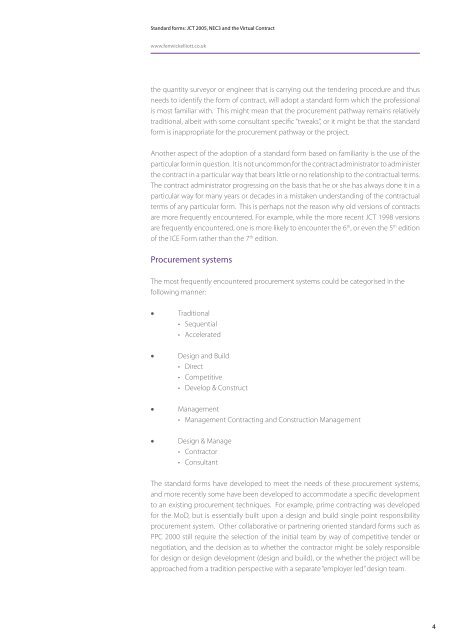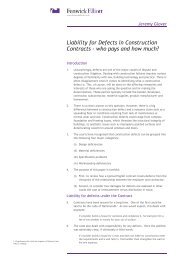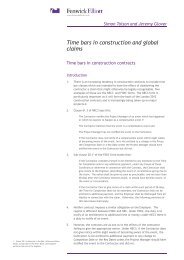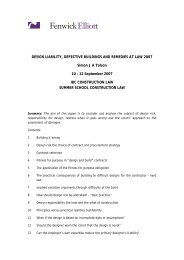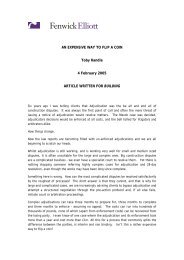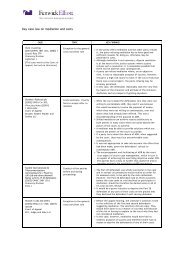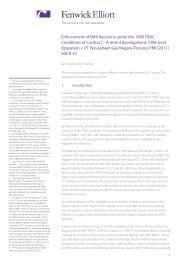Standard forms: JCT 2005, NEC3 and the Virtual ... - Fenwick Elliott
Standard forms: JCT 2005, NEC3 and the Virtual ... - Fenwick Elliott
Standard forms: JCT 2005, NEC3 and the Virtual ... - Fenwick Elliott
Create successful ePaper yourself
Turn your PDF publications into a flip-book with our unique Google optimized e-Paper software.
<strong>St<strong>and</strong>ard</strong> <strong>forms</strong>: <strong>JCT</strong> <strong>2005</strong>, <strong>NEC3</strong> <strong>and</strong> <strong>the</strong> <strong>Virtual</strong> Contract<br />
www.fenwickelliott.co.uk<br />
<strong>the</strong> quantity surveyor or engineer that is carrying out <strong>the</strong> tendering procedure <strong>and</strong> thus<br />
needs to identify <strong>the</strong> form of contract, will adopt a st<strong>and</strong>ard form which <strong>the</strong> professional<br />
is most familiar with. This might mean that <strong>the</strong> procurement pathway remains relatively<br />
traditional, albeit with some consultant specific “tweaks”, or it might be that <strong>the</strong> st<strong>and</strong>ard<br />
form is inappropriate for <strong>the</strong> procurement pathway or <strong>the</strong> project.<br />
Ano<strong>the</strong>r aspect of <strong>the</strong> adoption of a st<strong>and</strong>ard form based on familiarity is <strong>the</strong> use of <strong>the</strong><br />
particular form in question. It is not uncommon for <strong>the</strong> contract administrator to administer<br />
<strong>the</strong> contract in a particular way that bears little or no relationship to <strong>the</strong> contractual terms.<br />
The contract administrator progressing on <strong>the</strong> basis that he or she has always done it in a<br />
particular way for many years or decades in a mistaken underst<strong>and</strong>ing of <strong>the</strong> contractual<br />
terms of any particular form. This is perhaps not <strong>the</strong> reason why old versions of contracts<br />
are more frequently encountered. For example, while <strong>the</strong> more recent <strong>JCT</strong> 1998 versions<br />
are frequently encountered, one is more likely to encounter <strong>the</strong> 6 th , or even <strong>the</strong> 5 th edition<br />
of <strong>the</strong> ICE Form ra<strong>the</strong>r than <strong>the</strong> 7 th edition.<br />
Procurement systems<br />
The most frequently encountered procurement systems could be categorised in <strong>the</strong><br />
following manner:<br />
• Traditional<br />
• Sequential<br />
• Accelerated<br />
• Design <strong>and</strong> Build<br />
• Direct<br />
• Competitive<br />
• Develop & Construct<br />
• Management<br />
• Management Contracting <strong>and</strong> Construction Management<br />
• Design & Manage<br />
• Contractor<br />
• Consultant<br />
The st<strong>and</strong>ard <strong>forms</strong> have developed to meet <strong>the</strong> needs of <strong>the</strong>se procurement systems,<br />
<strong>and</strong> more recently some have been developed to accommodate a specific development<br />
to an existing procurement techniques. For example, prime contracting was developed<br />
for <strong>the</strong> MoD, but is essentially built upon a design <strong>and</strong> build single point responsibility<br />
procurement system. O<strong>the</strong>r collaborative or partnering oriented st<strong>and</strong>ard <strong>forms</strong> such as<br />
PPC 2000 still require <strong>the</strong> selection of <strong>the</strong> initial team by way of competitive tender or<br />
negotiation, <strong>and</strong> <strong>the</strong> decision as to whe<strong>the</strong>r <strong>the</strong> contractor might be solely responsible<br />
for design or design development (design <strong>and</strong> build), or <strong>the</strong> whe<strong>the</strong>r <strong>the</strong> project will be<br />
approached from a tradition perspective with a separate “employer led” design team.<br />
4


